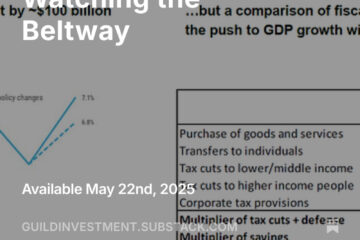Interest Rates
At Guild Investment Management, we agree that the world is in a period of low global growth and prevalent deflationary influences. We are also in a period of banking restructuring, and as a result, we may see slower world growth for a few years. In spite of this situation, U.S. interest rates are too low — even for a sluggish environment.
We have been bearish on bonds for many months, and on income stocks for the last few weeks as well, and we see no reason to change that attitude. Higher interest rates lie ahead even if they fluctuate over the next few months. There is no doubt that U.S. interest rates are absurdly low, and unless the world falls into a depression, they cannot move a great deal lower. Clearly, part of the reason that rates are so low in the U.S. is the global economic backdrop. QE everywhere is forcing many to come to the U.S. for their investing, to take advantage of a strong U.S. dollar and higher interest rates than in Europe. If the U.S. were somehow divorced from the world economy, rates would be higher in this country.
Many institutional investors must own bonds in order to comply with their mandate. Retail investors own bonds because they have been told that they are conservative. During rising interest rate periods, bonds have historically been a terrible investment.
In our view, owning bonds, or owning those income stocks which cannot quickly and consistently raise dividends, is a losing game for the next several years. As experienced investors will tell you, cash is far superior to long-term bonds when rates are rising. When rates rise enough, after income stocks and bonds fall a great deal, bargains appear. Those investors with cash will be the only ones who have an opportunity to benefit from the low prices. Those who have held income instruments will have losses, and not cash. Those with cash can buy cheaply.
For those investors who must own bonds, keep your bond maturities as short as possible.
Today, U.S. government employment data came out showing that many new jobs were created, adding to many new jobs created over the last few months. Some who had left the employment rolls returned. The current unemployment rate is 5.5 percent in the U.S., and the labor participation rate is rising as formerly discouraged job-seekers are once again added to the payrolls.
Our Concern
Short-term rates have been held down by the Fed and years of QE programs, but long-term rates are not under Fed control. Recently, long term interest rates have been moving higher. In January 2015, U.S. 10-year Treasury bond yields were below 1.70 percent, and today they are at 2.40 percent – in other words, the yield has risen over 40 percent.
At Guild Investment Management, we have a plan to deal with this trend based upon 50 years of market experience and long institutional memory about how deflation, inflation, and markets work. Many market participants will be surprised at what happens to the value of their income investments as interest rates rise, as they have only experienced falling long-term interest rates for over 30 years.

